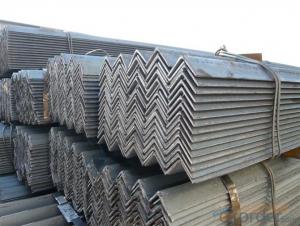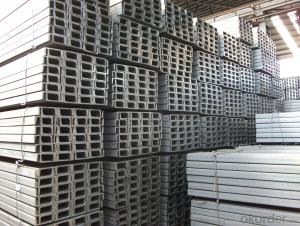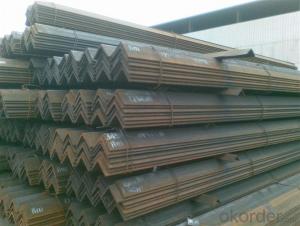S235 S355 SS400 A36 Q235 Q345 Construction Structural Hot Rolled Angle Iron or Equal Angle Steel
- Loading Port:
- Tianjin
- Payment Terms:
- TT OR LC
- Min Order Qty:
- 25 m.t.
- Supply Capability:
- 30000 m.t./month
OKorder Service Pledge
OKorder Financial Service
You Might Also Like
Packaging & Delivery
| Packaging Detail: | standard sea worhy package in bundles or at customer's request |
| Delivery Detail: | within 30 days after receive the deposit |
Specifications
Construction structural hot rolled Angle steel
size : 20*20 - 200*200 mm
Thickness : 3-20 mm
Material :S235 S355 SS400 A36
Construction structural hot rolled Angle steel
Product Description
Angle steel is commonly known as angle , its the long shape steel that both sides each other into vertical angle . Divided into equal angle and unequal angle .According to the stress of the structure of the different needs , angles can make into various components , also can make members between the joints widely used in various building structure , such as the beam , bridges , transmission , tower , lifting transportation machinery , ship , industrial furnace , reaction tower , container frame and warehouse .
Product Description
Angle steel is widely used in various building structure and engineering structure.
a.) beam, bridges, ship;
b.) transmission tower, reaction tower;
c.) lifting transportation machinery;
d.) industrial furnace;
e.) container frame, warehouse goods shelves, etc.
Standard | AISI, ASTM, BS, DIN, GB, JIS, etc mild angle steel |
Grade | Q235, Q345, SS400, A36, S235JR,S355JR, ST37-2,ST52, etc |
Equal Angle steel | Type: 2.5#-20# Size: 25-200mm Thickness: 3.0-20mm Weight: 0.597-71.168kg/m |
Unequal Angle steel | Type: 2.5/1.6-20/12.5 Long Side: 25-200mm Short Side: 16-125mm Thickness: 3.0-18mm Weight: 1.687-43.588kg/m |
Length | 5.8-12.0m OR according to client's request |
Element Contect | C<0.22% Si:<0.16% Mn: 0.30—0.65% P<0.060% S<0.060% |



- Q: Can steel angles be used for manufacturing support brackets?
- Yes, steel angles can be used for manufacturing support brackets. Steel angles are commonly used in construction and manufacturing industries due to their strength, durability, and versatility. They provide excellent support and stability, making them ideal for creating brackets that can withstand heavy loads and provide structural support.
- Q: Can steel angles be used for support structures?
- Support structures can indeed utilize steel angles. In the construction and engineering sectors, these angles are frequently employed for a range of purposes, including delivering stability and support to structures. The inherent L-shape of steel angles facilitates simple bolting or welding, rendering them ideal for crafting robust and long-lasting support structures. Common applications include building frames, roof trusses, bridges, and industrial platforms. Furthermore, steel angles possess exceptional load-bearing capacity and the ability to withstand bending and twisting forces, thus establishing themselves as a dependable option for support structures.
- Q: Can steel angles be used in telecommunications or broadcasting structures?
- Yes, steel angles can be used in telecommunications or broadcasting structures. Steel angles are commonly used in construction due to their strength, durability, and versatility. They can provide structural support and stability to various components of telecommunications and broadcasting structures, such as antenna mounts, equipment racks, and cable trays. Additionally, steel angles can be easily fabricated and customized to meet specific design requirements, making them suitable for a wide range of applications in the telecommunications and broadcasting industry.
- Q: How do steel angles perform under dynamic loads?
- Steel angles generally perform well under dynamic loads due to their inherent strength and durability. The structural shape of steel angles, characterized by their L-shaped cross-section, provides excellent resistance to bending and torsional forces. This design allows them to efficiently distribute dynamic loads and resist deformation, making them suitable for various applications in construction, engineering, and manufacturing industries. However, the specific performance of steel angles under dynamic loads can vary depending on factors such as the grade and quality of the steel, the magnitude and frequency of the dynamic load, and the overall design and reinforcement of the structure.
- Q: Can steel angles be used in the construction of industrial chimneys?
- Steel angles are indeed applicable in the construction of industrial chimneys. Their strength, durability, and versatility make them a popular choice for various construction projects. When it comes to industrial chimneys, steel angles provide the necessary support and stability. They can be integrated into the design to reinforce the framework, especially at the corners and joints where extra strength is needed. Moreover, steel angles can be utilized to establish a solid base or foundation, ensuring stability and preventing any potential structural problems. In summary, steel angles are well-suited for building industrial chimneys due to their ability to withstand the extreme temperatures and harsh conditions associated with chimney operation.
- Q: What are the different types of steel angles used in manufacturing industries?
- In manufacturing industries, there is a wide variety of steel angles utilized for different purposes. These angles possess unique characteristics that make them suitable for specific applications. 1. Unequal Leg Angles, also known as L-shaped angles, feature one longer leg and one shorter leg. They find common usage in construction and structural engineering due to their versatility. These angles offer exceptional strength and stability, making them ideal for supporting heavy loads and establishing structural connections. 2. Equal Leg Angles, also known as L-shaped angles, have both legs of equal length. They are extensively employed in manufacturing industries for diverse purposes, including bracing, framing, and supporting structures. These angles exhibit good resistance to bending and provide stable connections in various applications. 3. Stainless Steel Angles are crafted from a corrosion-resistant steel alloy, primarily comprising chromium. They possess remarkable durability, resistance to rust, and excellent strength properties. Stainless steel angles find widespread use in industries such as food processing, chemical processing, and marine manufacturing, where corrosion resistance is of utmost importance. 4. Galvanized Steel Angles are coated with a layer of zinc to safeguard them against corrosion and rust. This zinc coating ensures exceptional durability and longevity, rendering galvanized steel angles suitable for outdoor and exposed applications. They are commonly employed in industries like construction, agriculture, and transportation. 5. Rolled Steel Angles are manufactured by rolling a steel plate or sheet into the desired shape. These angles offer an excellent strength-to-weight ratio and can be produced in varied sizes and thicknesses. Rolled steel angles find extensive usage in construction, machinery, and fabrication industries for structural support and framing applications. 6. Slotted Steel Angles possess holes or slots along their length, allowing for flexibility in terms of fastening methods. They are frequently employed in shelving systems, racking, and storage solutions as they allow for easy adjustment and customization. Slotted steel angles offer versatility and convenience in manufacturing industries where quick assembly and reconfiguration are required. In summary, the assortment of steel angles utilized in manufacturing industries provides a range of properties and advantages. The choice of angle depends on the specific application, requirements for strength, corrosion resistance, and other factors that guarantee optimal performance and durability in the given application.
- Q: Can steel angles be used for electrical conduits?
- Steel angles cannot serve as electrical conduits. Electrical conduits are commonly made from non-metallic materials like PVC or metal materials such as galvanized steel or aluminum. Steel angles, on the other hand, are utilized for structural support and reinforcement in construction endeavors, but they are not intended or appropriate for use as electrical conduits. Electrical conduits have specific insulation, protection, and grounding requirements that steel angles do not fulfill. To ensure the integrity and efficiency of electrical installations, it is crucial to employ appropriate electrical conduits that satisfy the necessary safety standards.
- Q: What is the typical size range for steel angles?
- The typical size range for steel angles varies, but commonly, they range from 1/2 inch to 8 inches in width and thickness.
- Q: What are the different types of steel angle connections used in seismic design?
- Seismic design incorporates various types of steel angle connections that are commonly utilized. These connections are specifically engineered to withstand the forces and movements experienced during seismic events. Several types of steel angle connections used in seismic design are as follows: 1. Bolted Flange Plate Connection: This connection involves the bolting of a steel plate to the flanges of two angle sections. It demonstrates excellent resistance against lateral and vertical forces while accommodating rotational movements. 2. Welded Flange Plate Connection: Similar to the bolted flange plate connection, this connection entails the welding of a steel plate to the flanges of two angle sections. It offers superior strength and stiffness but is less ductile when compared to the bolted version. 3. Extended Single Plate Connection: This connection is established by extending a single plate beyond the flanges of two angle sections and welding it to both flanges. It provides commendable resistance against lateral and vertical forces while accommodating some degree of rotation. 4. Double Angle Connection: In this connection, two angle sections are joined together using bolts or welds. It possesses high strength and stiffness, effectively resisting lateral and vertical forces. 5. Diagonal Brace Connection: This connection involves connecting diagonal braces to the flanges of two angle sections. It enhances resistance against lateral forces and effectively controls building sway during seismic events. 6. Gusset Plate Connection: This connection employs a gusset plate to connect two or more angle sections. It demonstrates good strength and stiffness while effectively resisting lateral and vertical forces. Each of these steel angle connections possesses its own advantages and disadvantages. The choice of connection relies on factors such as structural design requirements, loadings, and the level of seismic activity in the region. It is crucial to carefully consider these factors and seek consultation with structural engineers to ensure the appropriate connection type is employed for a seismic design project.
- Q: How do steel angles perform under high temperatures?
- Due to their high melting point and exceptional heat resistance, steel angles exhibit excellent performance in high-temperature conditions. Steel, a widely utilized material in construction and engineering, is renowned for its robustness and durability. Steel angles, when subjected to elevated temperatures, maintain their structural integrity and do not easily deform or weaken. This is primarily due to steel's elevated melting point, typically ranging from 1370 to 1530 degrees Celsius (2500 to 2800 degrees Fahrenheit), enabling it to endure extreme heat without significant harm. Moreover, steel possesses outstanding heat resistance, enabling efficient heat dissipation and maintaining stability when confronted with high thermal loads. Consequently, steel angles are suitable for applications involving elevated temperatures, such as industrial furnaces, power plants, or high-temperature environments. However, it is crucial to acknowledge that the specific performance of steel angles under high temperatures can vary depending on the steel's grade and composition, as well as the intensity and duration of heat exposure.
Send your message to us
S235 S355 SS400 A36 Q235 Q345 Construction Structural Hot Rolled Angle Iron or Equal Angle Steel
- Loading Port:
- Tianjin
- Payment Terms:
- TT OR LC
- Min Order Qty:
- 25 m.t.
- Supply Capability:
- 30000 m.t./month
OKorder Service Pledge
OKorder Financial Service
Similar products
Hot products
Hot Searches
Related keywords




























